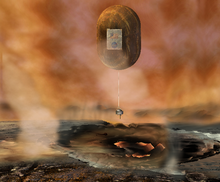New Frontiers Program
The New Frontiers program is one of NASA's programs for exploring the solar system through space probes . The projects in this program are classified as medium-class missions in NASA's long-term exploration strategy (up to around 2020) and thus form the link between the smaller, simpler, more cost-effective (US $ 300–500 million) missions of the Discovery program and the large, costly (US $ 800–2800 million), complex " flagship " missions.
The research strategy for the New Frontiers program was first formulated - to accommodate the New Horizons space probe - in 2002 and the first budget for this NASA program was established in 2003. The name goes back to John F. Kennedy , who propagated the search for "new frontiers" as a domestic political motto in his government program in 1961.
The New Frontiers program represents the change in the new path of NASA. NASA now wants to put a greater emphasis on the study of the solar system . More detailed investigations are now to be carried out in the field of planetology . NASA has invited the scientific communities in the US and around the world to participate in the program.
Missions
The first probe launched under this program in 2006 is the Pluto New Horizons probe .
Juno launched the second probe to Jupiter in August 2011 .
In 2008 the selection process for the third mission began. In December 2009 NASA announced three final candidates:
- a Venus Lander to study the atmosphere and a soil sample. Name: Venus In-Situ Explorer (VISE), now renamed Surface and Atmosphere Geochemical Explorer (SAGE).
- OSIRIS-REx (Origins Spectral Interpretation Resource Identification Security Regolith Explorer), a probe designed to examine an asteroid , land on it, take rock samples and bring them back to Earth. The goal is (101955) Bennu , a near-Earth asteroid that hits Earth in 2170 with a probability of 1: 1800 . It is characterized by a very carbonaceous surface on which complex organic molecules may also be present.
- MoonRise, a return of material samples from the South Pole Aitken Basin of the Earth's moon .
A flyby probe to Saturn was not shortlisted. The three finalists initially received additional funds for more detailed planning. On May 25, 2011 NASA announced that it had decided on the OSIRIS-REx mission . In April 2014, NASA finally approved the project. It started on September 8, 2016.
Fourth mission
The fourth New Frontiers mission was selected from among applications for the following concepts. A total of 12 mission concepts were submitted.
- A sample return mission to a comet.
- A sample return mission to the South Pole Aitken Basin of the moon.
- A probe into the atmosphere of Saturn occurs.
- A probe to the Jupiter Trojans . (In the meantime planned as part of the Discovery program , see Lucy space probe ).
- A Venus Lander that is supposed to investigate the atmosphere and a soil sample (Venus In-Situ Explorer).
- A probe to the Saturn moons Titan and Enceladus .
In December 2017, NASA selected two finalists: CAESAR , a sample return mission to comet 67P / Churyumov-Gerasimenko , which has already been intensively researched by the Rosetta probe , and Dragonfly , a dual quadrocopter that demonstrates the prebiotic chemistry of titanium in a variety of different locations should investigate. In June 2019 the decision was made for Dragonfly. The probe is scheduled to start in 2026 and reach Titan in the mid-2030s .
Web links
- NASA: New Frontiers (English)
- NASA: Solar System Strategic Exploration Plans (English)
Individual evidence
- ↑ NASA Strategic Exploration Plans: Mission Classes for Solar System Exploration ( Memento of September 8, 2006 in the Internet Archive ), Aug. 28, 2006 (English)
- ↑ NASA Chooses Three Finalists for Future Space Science Mission to Venus, an Asteroid or the moon: http://www.nasa.gov/home/hqnews/2009/dec/HQ_09-296_New_Frontiers_Candidates.html December 29, 2009
- ↑ Osiris-Rex New Frontiers Proposal: http://futureplanets.blogspot.com/2010/01/osiris-rex-new-frontiers-proposal.html December 29, 2009
- ↑ MoonRise: ISRO and JPL want to explore the moon
- ↑ NASA Solar System Roadmap: Solar System Exploration ( Memento from August 1, 2007 in the Internet Archive ) (PDF), September 2006 (English)
- ↑ NASA to Launch New Science Mission to Asteroid in 2016: http://www.nasa.gov/topics/solarsystem/features/osiris-rex.html May 25, 2011
- ^ Launch Schedule. Spaceflight Now, accessed January 29, 2016 .
- ↑ NEW FRONTIERS FOURTH ANNOUNCEMENT OF OPPORTUNITY ANNOUNCEMENTS NASA, August 10, 2016, accessed November 7, 2016.
- ↑ Bill Keeter: NASA Receives Proposals for Future Solar System Mission. NASA , May 5, 2017, accessed December 24, 2017 .
- ↑ Karen Northon: NASA Invests in Concept Development for missions to Comet, Saturn Moon Titan. NASA , December 20, 2017, accessed December 24, 2017 .
- ↑ Andrea Witze: NASA drone will soar over Saturn's largest moon. In: Nature. June 27, 2019, accessed June 27, 2019 .



